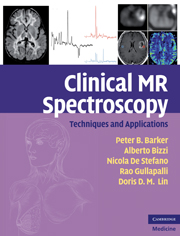Book contents
- Frontmatter
- Contents
- Preface
- Acknowledgments
- Abbreviations
- 1 Introduction to MR spectroscopy in vivo
- 2 Pulse sequences and protocol design
- 3 Spectral analysis methods, quantitation, and common artifacts
- 4 Normal regional variations: brain development and aging
- 5 MRS in brain tumors
- 6 MRS in stroke and hypoxic–ischemic encephalopathy
- 7 MRS in infectious, inflammatory, and demyelinating lesions
- 8 MRS in epilepsy
- 9 MRS in neurodegenerative disease
- 10 MRS in traumatic brain injury
- 11 MRS in cerebral metabolic disorders
- 12 MRS in prostate cancer
- 13 MRS in breast cancer
- 14 MRS in musculoskeletal disease
- Index
- References
3 - Spectral analysis methods, quantitation, and common artifacts
Published online by Cambridge University Press: 04 August 2010
- Frontmatter
- Contents
- Preface
- Acknowledgments
- Abbreviations
- 1 Introduction to MR spectroscopy in vivo
- 2 Pulse sequences and protocol design
- 3 Spectral analysis methods, quantitation, and common artifacts
- 4 Normal regional variations: brain development and aging
- 5 MRS in brain tumors
- 6 MRS in stroke and hypoxic–ischemic encephalopathy
- 7 MRS in infectious, inflammatory, and demyelinating lesions
- 8 MRS in epilepsy
- 9 MRS in neurodegenerative disease
- 10 MRS in traumatic brain injury
- 11 MRS in cerebral metabolic disorders
- 12 MRS in prostate cancer
- 13 MRS in breast cancer
- 14 MRS in musculoskeletal disease
- Index
- References
Summary
Key points
Correct post-processing and quantitation are key aspects of in vivo MRS.
Filtering, phase-correction and baseline correction improve MRS data.
Peak area estimation can be done using parametric or non-parametric routines in either the time domain or frequency domains.
“LCModel” software is becoming widely used and accepted, particularly for single-voxel MRS data.
MRSI processing requires additional steps; k-space filtering and other manipulations can improve MRSI data quality.
A variety of strategies are available for quantitation, based on either internal or external reference standards, or phantom replacement methodology.
Quantitation routines should take into account voxel composition, particularly the amount of CSF partial volume present.
MRS is sensitive to field inhomogeneity and other artifacts.
Introduction
Methods for spectral analysis and the quantitative analysis of spectral data are arguably as important as the techniques used to collect the data; the use of incorrect analysis methods can lead to systematic errors or misinterpretation of spectra. In general, the ultimate goal of spectral analysis is to determine the concentrations of the compounds present in the spectra. In MRS, the area under the spectral peak is proportional to the metabolite concentration; however, determining the proportionality constant can be challenging. In addition, peak area measurements in in-vivo spectroscopy are complicated by resonance overlap, baseline distortions, and lineshapes that often only poorly approximate conventional models such as Gaussian or Lorentzian functions. Therefore, quantitative analysis of in vivo MRS data is challenging. This chapter reviews basic spectral processing techniques, methods for determining peak areas, and strategies for calculating metabolite concentrations.
Information
- Type
- Chapter
- Information
- Clinical MR SpectroscopyTechniques and Applications, pp. 34 - 50Publisher: Cambridge University PressPrint publication year: 2009
References
Accessibility standard: Unknown
Why this information is here
This section outlines the accessibility features of this content - including support for screen readers, full keyboard navigation and high-contrast display options. This may not be relevant for you.Accessibility Information
- 2
- Cited by
